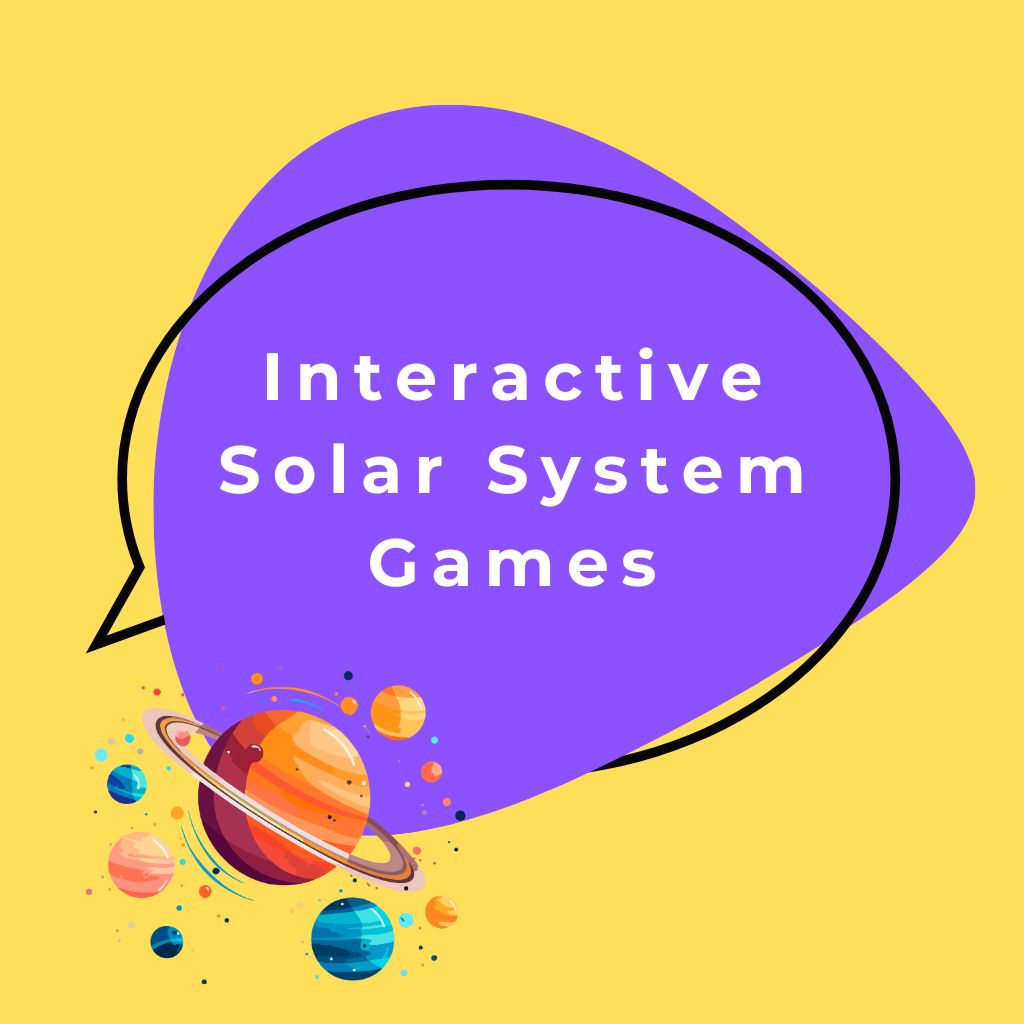This site contains affiliate links to products. I may receive a commission for purchases made through these links.
Ever wondered how to make learning about the solar system fun? I’ve got the perfect solution for you: interactive solar system games. These games aren’t just entertaining, they’re also a fantastic way to absorb complex information about our universe.
Interactive games can transform the way we learn, particularly when it comes to topics as vast as the solar system. It’s no secret that we tend to remember things better when we’re actively engaged. That’s where these games come into play.
Benefits of Interactive Learning
Stepping into this vibrant era of digital learning, we can’t help but recognize the significant advantages of interactive learning. Truly, it’s revolutionized the education sector, bringing the solar system to our fingertips, literally!
Engagement stands out as one of the primary benefits. Traditional classroom teaching, though essential, often restricts students to passive learning. Interactive solar system games, conversely, cultivate an active learning atmosphere. You’ll find students excitedly exploring planets, maneuvering through asteroid belts, and watching solar flares near the sun! As learners dive into these stimulating experiences, their engagement soars, triggering deeper understanding and retention of knowledge.
Yet the perks don’t stop there: critical thinking is further boosted by interactive learning. Visual and tactile experiences provided by solar system games stimulate thought processes, fostering problem-solving skills. They’re not just absorbing data; they’re interpreting, analyzing, and applying it logically. Is there a more exciting way to enhance strategy and critical thinking? I think not.
Let’s not forget about instant feedback. Traditional quizzes and exams often leave students waiting days for results. With interactive learning, students get immediate feedback, aiding in timely corrections and adjustments. This instant gratification not only strengthens learning but also kindles motivation. Pie charts, progress bars and unlockable levels provide instant gratification that keeps the learning going!
Introduction to the Solar System
Adding to the preceding discussion on interactive learning, let’s delve into a fascinating context where such learning can be applied: The solar system.
The solar system we live in is home to a host of celestial objects, each with its unique features and phenomena. At the center, is the Sun, a ball of hot, glowing gases. Next, we’ve got highly diverse planets, asteroids, and comets floating around in vast space, all locked in the Sun’s gravitational pull. Factors such as their size, composition, and distance from the Sun result in distinct environments and characteristics for each of these celestial bodies.
Speaking about planets, our solar system houses eight of them. The innermost four planets, Mercury, Venus, Earth, and Mars are terrestrial planets with rocky surfaces. The outer planets: Jupiter, Saturn, Uranus, and Neptune are gas giants and ice giants. Labeling them simply as inner or outer, terrestrial or giants doesn’t do justice to the variety they display. Each planet has a diverse climate, size, and number of moons.
Adding to the complexity, come innumerable asteroids, meteoroids, and comets that make our solar system a dynamic and evolving entity. It’s crucial, therefore, for students to not just understand these disparate components but also their relationships and influences on each other, and concede the fact that the further we explore, the more mysterious our universe gets.
Putting such a complex system into traditional classes can be daunting and uninviting. This is where interactive solar system games come into play, turning what might be a tedious topic into an exciting journey of exploration and discovery.
In the following sections, we’ll look at how these educational games work, their advantages, and why they might be the future of education.
From here, we carry on to specifics: the different types of interactive solar system games out there and why they’re so effective. Stay tuned to discover more about this innovative educational technique that is making learning the solar system a joy for students around the globe.
Importance of Making Learning Fun
In this evolving educational landscape, it’s crucial to understand the significance of making learning an enjoyable experience. Traditionally, learning has often been equated with rigidity and monotony. However, that paradigm is shifting towards a fun, interactive, and enjoyable experience. Why this shift, you might ask? The answer is simple: making learning fun can lead to significant improvements in knowledge retention and student engagement.
Interactive learning games like those focused on the solar system present a unique opportunity to ignite a student’s curiosity. They provide an avenue for exploration, allowing students to traverse the vast cosmic arena and engage with the celestial bodies in a fun and exciting way. This sense of adventure stimulates a passionate interest in learning, which can lead to a deeper and more thorough understanding of the subject matter.
A fun learning environment isn’t just about enjoyment. It’s also about producing positive educational outcomes. It’s no secret that when students are enjoying themselves, they’re more likely to be invested in their learning. They’re more motivated, attentive, and eager to understand new concepts.
Research supports this too. It shows that a fun and interactive learning environment can increase student engagement by up to 90%, bolstering their understanding and retention of the material.
Here’s a brief look at how student engagement rates improve when learning is fun, based on a study by the University of Minnesota:
| Engagement Level | Traditional Learning | Fun Interactive Learning |
|---|---|---|
| Low | 40% | 10% |
| Medium | 30% | 20% |
| High | 20% | 60% |
| Very High | 10% | 90% |
Incorporating fun elements into learning, such as interactive solar system games, has the potential to revolutionize the way students learn. As we delve further into this article, we’ll explore the diverse range of interactive games available, how they facilitate learning about the solar system and why they’ve become such effective tools in modern education. As educators, it’s crucial we adapt and tap into these innovative learning methods to nurture the astronauts, astrophysicists, and astronomers of tomorrow.
Types of Interactive Solar System Games
Diverse options for interactive solar system games are easily accessible. There’s an option to fit every preference! They go beyond basic rote memorization of facts; they involve engaging activities that stimulate both creativity and curiosity. Which one should you introduce into your classroom or homeschool curriculum? Let’s delve into some of the best choices.
Simulation Games: Simulation games mimic real-world space exploration. They grant a hands-on experience as you build your own spacecraft, go on space missions, and explore celestial bodies in our galaxy. Top games such as ‘Kerbal Space Program’ and ‘Universe Sandbox’ showcase the vastness of the universe while simplifying complex astrophysical phenomena. They’re a stellar choice for older learners who want an in-depth understanding of the solar system.
Educational Apps and Games: With the rise of digital tech, dozens of educational apps have surfaced. They’re custom built to make learning about the solar system both fun and engaging. They often incorporate quizzes, puzzles, and fun informational videos. Apps like ‘SkyView’ and ‘Star Walk’ stand out due to their user-friendly design and interactive features. Ideal for learners of all ages, they offer a fun, accessible way to learn about the cosmos.
Virtual Reality (VR) Experiences: For a more immersive learning experience, VR games are the way to go. With these, you can travel to Mars or walk on the moon while still in your living room! Classic VR games like ‘Titans of Space’ take you on a guided tour of our solar system, providing a truly unforgettable educational experience.
As I continued my exploration, it became abundantly clear that interactive solar system games provide an engaging and fun way to learn about our universe. Regardless of age or experience level, there’s a game waiting to align with any learner’s interests.
The learning gains from these interactive games are undeniable. The next segment of this article will provide an in-depth review of these options, examining the ways they make learning about the solar system a galactic adventure.
Exploring the Planets and their Features
In interactive solar system games, users can take a virtual trip through the cosmos, learning about different planets and their unique features. By controlling a virtual spacecraft, they can explore each planet, uncovering its topography, climate, and atmosphere.
Simulation games are unarguably the top choice for exploring the planets and their characteristics. Games like Universe Sandbox or Cosmic-Wander: An Interactive Journey offer a realistic 3D representation of our planets, complete with accurate atmospheres, axial tilts, and rotation speeds. For instance, in Cosmic-Wander, you’ll notice that one day on Venus is equivalent to 243 Earth days. Isn’t that fascinating?
Educational apps also offer engaging platforms for exploring the nuances of our solar system. Apps like Solar Walk 2 and SkyView Lite bring the solar system to the palm of your hand. You can zoom in and out, rotate, flip, or slice the planets to your heart’s content.
For a more immersive experience, virtual reality games can’t be beaten. Don the VR headset and prepare to be transported to an entirely different realm. Games like Titans of Space Plus allow you to marvel at the grandeur of the planets as if you’re standing there in person. However, it’s key to note that access to VR technology could pose as a limitation to some users.
Below is a table summarizing different game types and their respective examples:
| Game Type | Examples |
|---|---|
| Simulation games | Universe Sandbox, Cosmic-Wander |
| Educational apps | Solar Walk 2, SkyView Lite |
| Virtual Reality games | Titans of Space Plus |
Adult, children, novice, or expert – interactive solar system games are an unparalleled choice for learning about the planets and their properties. There’s no denying the engaging, and fun-filled learning adventure these games promise.
Understanding Astronomical Concepts through Games
Interactive solar system games have revolutionized the way we understand the universe. They offer practical learning experiences that traditional educational methods can’t. These games let me virtually explore planets, stars, galaxies, and different phenomena, making complex astronomical concepts easily digestible.
Games like Universe Sandbox and Cosmic-Wander allow me to create and interact with my solar system. I can change different variables, like mass, density, gravity, and much more. This way, I’m not just learning from a textbook. Instead, I’m experimenting and witnessing the results firsthand. It’s an interesting approach to understanding the gravity concept or the habitable zones of the solar system.
In addition to this, educational apps like Solar Walk 2 further push the boundaries of interactive learning. With a swipe of a finger, I can get a 3D view of any celestial body in the solar system, making learning dynamic and fun. It’s a perfect approach to understand orbital paths or the unique properties of different planets.
And if you really want an immersive experience, virtual reality games like Titans of Space Plus bring the universe right in front of your eyes. You get to take a journey right from your living room to different planets and moons, unhindered by the physical restrictions of the real world.
It’s also worth mentioning that these games, though primarily educational, focus on being entertaining to ensure they’re engaging for all age groups. They turn learning about the universe and its complex phenomena into a fun quest rather than a boring chore.
Here’s a quick overview of the games and their unique features:
| Games | Unique Features |
|---|---|
| Universe Sandbox | User-defined variables, Real-time physics |
| Cosmic-Wander | Personalized solar system, In-depth exploration |
| Solar Walk 2 | 3D view of celestial bodies, Information on orbital paths |
| Titans of Space Plus | Virtual reality, Journey through different planets and moons |
As we continue, we’ll explore how these interactive solar system games have influenced our perception of the universe.
Enhancing Problem-Solving Skills
When it comes to interactive solar system games, the benefits extend far beyond visualizing celestial bodies in the galactic playground. These strategically-designed games develop and fine-tune vital problem-solving skills.
Each game works like a situational test, allowing users to confront and handle complex game scenarios. They exercise skills such as critical thinking, decision making, strategic planning, and forecasting – attributes often lacking in traditional learning environments.
Take Universe Sandbox, for instance. It’s not just a cosmic phenomenon simulation. Instead, it challenges players to control gravity and manage different celestial objects’ orbits within a virtual galaxy. Deciding the fate of entire planets and ecosystems requires a deep understanding of virtual physics principles and a keen sense of prediction.
Similarly, Solar Walk 2 demands a high level of strategic planning. Balancing resources while maintaining a sustainable habitat on alien planets is no easy task. It’s an exciting journey that demands quick, rational decisions and fast adaptation to changing scenarios.
Then there’s Cosmic-Wander, an interactive galaxy explorer game where players bridge the interstellar distances using warp drives and stabilize their ship amidst gravitational anomalies. Overcoming these challenges sharpens the mind and boosts critical thinking abilities as players must anticipate the consequences of their actions and adapt their strategies in response to unexpected events.
The beauty of these games isn’t just in the virtual journey they offer. It’s in how they take a player’s natural curiosity about the universe, nourish it, and transform it into a trove of problem-solving skills. The immersive nature of these games, coupled with the mental exercise they provide, truly transforms the process of learning about the universe into an engaging, enriching, and thought-provoking experience.
Don’t forget to explore the game Titans of Space Plus with its unique perspective on planetary scales and distances, enriching the spatial cognition and adding a breadth to the understanding of the universe. But more on that later!
Who would’ve thought? Science education, reimagined as a game, turning gamers into real-life problem solvers. And they say you can’t learn anything from video games! It’s these experiences that push the boundaries of understanding, challenging users in unique and unexpected ways. And it’s clear to see, the lessons learned aren’t confined to the gaming universe, but echo into the real world, alongside real world problem solving.
Developing Critical Thinking Abilities
Taking a leap from the previous context, Interactive Solar System games not only build on knowledge but they also nurture critical thinking skills. It’s essential to understand that these aren’t just games, they’re strategic problem-solving simulations.
In these games, players are tasked with maneuvering celestial bodies, simulating the balance of cosmic resources, and strategizing to combat celestial challenges. Each decision made has a direct impact on the game’s progression. The stakes? They revolve around creating sustainable ecosystems, increasing planetary growth, or ensuring the very survival of virtual civilizations.
It’s fascinating how these games can morph the mind into a solution-oriented powerhouse. There are no set solutions, no predefined paths. Every player devises their plan, takes the plunge, analyzes outcomes, and iterates their strategies. It drives an individual to think, both creatively and logically, and to work through each challenge with a problem-solving mindset.
Consider the importance of these skills in our day-to-day life:
- Making informed decisions
- Evaluating situations objectively
- Handling stressful situations logically
- Planning and strategizing efficiently
Interactive solar system games give players the chance to practice and polish these skills in a low-risk, enjoyable environment. By dealing with virtual challenges, players hone their problem-solving skills, decision-making abilities, and strategic planning tactics. They learn to adapt and to innovate on the fly, applying new approaches to overcome each hurdle.
The beauty of it all lies in the immersive, interactive nature of the game. Instead of passively absorbing information, players actively engage in the learning process. It transforms the often daunting task of learning about the universe into an exciting, engaging, and enriching experience. A universe where I can test my strategic skills and critical thinking ability? Sign me up!
Interactive Solar System games have fundamentally changed the landscape of learning and critical thinking development. They’ve harnessed the power of play to create a unique, practical learning platform that promises not only improved knowledge retention but a formidable boost in problem-solving prowess.
Conclusion
Interactive solar system games are more than just entertainment. They’re a powerful tool for learning and honing problem-solving skills. By challenging players to strategize and make informed decisions, these games foster critical thinking in an immersive, enjoyable environment. It’s this blend of fun and learning that makes them a game-changer in education. The real-world applications are far-reaching, turning gamers into real-life problem solvers.
It’s clear that these games have reshaped the learning landscape, proving that the power of play can be harnessed for practical learning. So, if you’re looking to learn about the universe and develop your critical thinking skills, give these games a shot. You won’t be disappointed.





